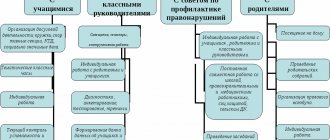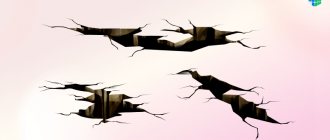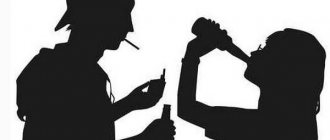Human behavior in society always implies compliance with generally accepted norms that regulate social relations in all spheres of human life: political, economic, social and spiritual. These social norms represent a certain set of rules of human behavior, non-compliance with which results in censure and condemnation. Society can apply various measures of public responsibility to violators of social norms, for example, in the form of censure from society.
What is deviant and delinquent behavior: meaning in sociology
Deviant (deviant) behavior is social behavior that does not correspond to already established social norms accepted by a certain group of people or the entire society.
There are forms of this behavior:
- Drunkenness;
- Addiction;
- Crime;
- Prostitution;
- Suicide.
Deviant behavior includes delinquency. The main difference is that delinquent behavior always involves illegal actions.
Delinquent behavior is a violation of social norms in which illegal actions occur.
Factors shaping delinquent behavior:
- Social conditions.
- Individual characteristics.
- Gender factor;
- Age factor;
- Constitutional features;
- Psychical deviations.
| Explanation of deviation and delinquency | Its essence |
| Biological | By its essence, each person has a certain mindset that predisposes him to a specific type of behavior. |
| Psychological | Deviance is a consequence of an individual’s individual qualities, his internal life attitudes, goals and dreams, which can be either innate or acquired. A delinquent act can lead to mental disorders. |
| Sociological |
|
Types of delinquent behavior:
- Infliction of bodily injury and damage;
- Theft;
- Vehicle theft;
- Sexual perversions.
Types of delinquent behavior
The main types of delinquent behavior are administrative violations, disciplinary offenses, and crimes.
Administrative offenses are anything that violates the peace of citizens and public order. This includes obscene language in public places, insulting behavior towards others, traffic violations and other actions. For example, this is a group of teenagers drinking alcohol in a park. Obscene language, demonstrative behavior, and possibly petty hooliganism. This also includes prostitution, distribution of pornography and exhibitionism.
Disciplinary offenses include violations of the rules of conduct during working hours. Regulated by the labor code. For example, absenteeism from work without a good reason, or being intoxicated at the workplace. As well as violation of security rules, any violations of work discipline and labor legislation.
Giphy
This already applies to adults, not teenagers. This is, for example, a driver who drinks from time to time. That is why taxi services introduce a medical examination before the start of a work shift.
Crime is the most dangerous type of delinquent behavior that causes harm to society. These are murder, theft, fraud, terrorism, vandalism and others. Punishment is determined by the Criminal Code. Punishment, depending on the severity of the crime, can range from community service and fines to imprisonment. Criminal liability applies to persons who have reached the age of sixteen; sometimes cases of fourteen-year-olds are also considered.
The very existence of the Criminal Code suggests that nothing stops a delinquent person except the fear of punishment. And the fear of punishment is not enough, otherwise there would be no need for prisons. But not everyone is prone to delinquent behavior; this is a certain type of personality.
Portrait of a person with delinquent behavior, examples from literature
A person with this type of behavior can be either a man or a woman. His main difference from the others is his isolation, a certain gloominess is possible. It often happens that the criminal is outwardly beautiful, which endears him to people. He is smart, suspicious, and may have childhood traumas.
Often in classical literature you can find heroes with delinquency, which is reflected in their actions. Thus, in his work “Lady Macbeth of Mtsensk,” Leskov tells the story of Catherine, who kills her father-in-law, husband, nephew, and a girl attracted by her lover. She also commits suicide at the end. This is a clear example of actions that deviate from the norm. It’s no secret that Rodion Raskolnikov from the novel “Crime and Punishment” is another representative of delinquent behavior: he kills an old money-lender and steals jewelry from her.
Delinquent behavior as a form of deviant behavior of a teenager’s personality
Panov Sergey
Delinquent behavior as a form of deviant behavior of a teenager’s personality
Man is fully responsible not only for his actions, but also for his inability to act."
J. Sartre
Adolescence is the most difficult and complex period, representing the time of personality . This age is characterized by the presence of a wide variety of psychological problems and difficulties, which are most often repressed due to the fear of awareness. It is during this period that the influence of the immediate environment affects with enormous force. Deviant behavior of adolescents in general and delinquent behavior in particular is a global problem in modern society.
Delinquent behavior is the actions of a specific individual that deviate from the laws established in a given society and at a given time, that threaten the well-being of other people or social order and are criminally punishable in their extreme manifestations. A person who exhibits illegal behavior is classified as a delinquent person ( delinquent , and the actions themselves are considered to be delinquents . Delinquent (from the Latin delinquens - offender)
- a subject whose
deviant behavior in its extreme manifestations constitutes criminal actions. Adolescence in general and early adolescence in particular represent a risk group for the formation of deviant behavior , including its extremely destructive form - delinquent (illegal and criminal) behavior .
The main reasons for the formation of delinquency are :
low level of culture and morality in the teenager's ;
raising a child in a single-parent family, divorce of parents;
death of a person significant to a teenager ;
mistakes in raising a child in the form of weak parental control, lack of punishment;
childhood psychotrauma;
physical violence against a child by parents;
imperfection of the child’s psyche during adolescence ;
desire to express himself , to assert himself in the company of friends;
desire to seem like an adult , thirst for vivid impressions;
poorly developed skills in establishing cause-and-effect relationships among schoolchildren;
availability of pornographic materials teenagers
degradation of personality , the predominance of base instincts in a person;
the individual has alcoholism or drug addiction;
disorders or psychiatric diagnoses in the individual
difficulties in social adaptation of the individual ;
aggressiveness;
low self-esteem in a teenager ;
low socio-psychological status of the child in the group of peers;
A teenager has a lot of free time ;
low intellectual level of personality , narrowness of thinking;
the teenager’s desire to earn money independently by any available means;
attempts to resolve conflicts and personal problems with the help of physical force;
poor development of willpower, a teenager’s tendency to show conformity ;
a teenager getting into an antisocial peer group;
As a rule, delinquent behavior is formed as a result of the simultaneous action of several negative factors.
Criminal behavior is a form of delinquent behavior . Not every behavior that deviates from the norm is delinquent , but all delinquent behavior is deviant . Until the recent past, the problem of delinquency and criminality in adolescents was studied mainly among boys. Only recently has there been increasing interest in gender differences in offending behavior . Thus, the problem of abnormal personality development of adolescents with unlawful behavior is systemic in nature and should be studied in a combination of interrelated aspects.
Methods for identifying delinquent behavior in adolescents :
One of the main principles of a psychologist’s work with delinquent adolescents is the creation of an atmosphere of real cooperation and partnership in relations with minors.
• Conversation, observation. The specialist collects anamnesis, asks about the peculiarities of intra-family interaction, the teenager’s , their onset, periodicity, and frequency. Evaluates the productivity of the contact, the characteristics of the teenager’s behavior during consultation (adequacy, aggressiveness, emotional instability, etc.)
.
• Questionnaire. Questions of specialized methods determine deviations in the moral sphere, a tendency to illegal acts, addictions, affective, aggressive behavior , deviations in the sexual sphere . The results of the study can be deliberately distorted or changed by the teenager . Tools such as the test “Determination of propensity for deviant behavior ”
.
• Psychological testing. Personality questionnaires and projective methods are used for a deeper study of the emotional-volitional sphere and character traits of a teenager . The results are used to identify the problem and select correction techniques. The “Pathocharacterological diagnostic questionnaire” is used
(PDO,
“Methodology of multilateral
personality ” (MMIL,
“Hand test”
(Hand-test, K. Thomas test
“Response in conflict situations”
, questionnaire
“Level of aggressiveness”
by B. Bass-Darki, A. Assinger test
“Aggression in relationships"
,
"Rosenzweig's Frustration Test"
, a test for identifying
personality accentuations by Leonhard , a modified Szondi portrait test, etc. In psychological research, the differentiation of delinquent and deviant behavior .
Correction of delinquent behavior in adolescents :
The correction is complex and involves the participation of such specialists as a psychiatrist, psychologist, social teacher, and parents. Correction of the behavior of adolescents with delinquent behavior is based on the development of positive personality traits and the elimination of distorted perceptions of social situations. Adaptation is focused on crowding out dangerous actions and stimulating socially useful activity. The following methods of helping teenagers :
• Cognitive-behavioral psychotherapy . Sessions are aimed at correcting the emotional state, destructive thoughts and ideas about one’s own “I”
, relationships in social groups.
The psychotherapist teaches the teenager reflexive thinking and develops skills of socially effective behavior .
• Family psychotherapy. Classes with teenagers and parents are conducted in the form of games and trainings. The goal is to develop and consolidate ways of productive interaction. Family members learn to communicate, collaborate, and plan leisure time. behavioral patterns that support delinquency are identified and corrected .
• Creative therapy. A promising direction in working with delinquent adolescents is art therapy . Creative activities allow you to openly express emotions and thoughts, objectively evaluate them, and overcome deviations in the motivational-volitional and emotional sphere. Drawing, dancing, modeling, and participation in theatrical performances are considered as an alternative way to spend free time.
Forecast and prevention:
The prognosis for delinquent behavior in adolescents is favorable with comprehensive pedagogical, psychological and medical assistance. A positive outcome is determined in 50-70% of cases. Prevention should begin from a very early age. It is important to devote time and effort to the upbringing and mental development of the child, to organize varied and useful leisure time, to support hobbies in sports and creativity. It is necessary to exclude situations of complete idleness, but maintain the possibility of passive rest. In a relationship, you need to show respect to the child, praise and encourage him for his achievements, building positive self-esteem. Success stimulates interest and passion for activities. Correct values and moral foundations, embedded in a child before adolescence , make it possible to resist negative information received from various sources .
co-author of the article Prokhorenko O. A. www.maam.ru/users/1422057/
Prevention of delinquent behavior in adolescentsconsultation on the topic
Measures to prevent delinquent behavior in adolescents
Changes in the socio-economic sphere in Russia have entailed changes in the state of the entire modern society. In the current situation, vulnerable groups of the population, which include minors, need special protection. The problem of deviant and delinquent behavior of minors is one of the most pressing today.
Delinquent behavior is the actions of a specific individual that deviate from the laws established in a given society and at a given time, that threaten the well-being of other people or social order and are criminally punishable in their extreme manifestations (E.V. Zmanovsky).
Delinquent behavior is one of the forms of deviant behavior that cannot be a positive phenomenon, it is always condemned and punished, such behavior is regulated by special social institutions: courts, investigative bodies, places of deprivation of liberty.
The beginning of delinquent behavior is absenteeism from school, joining an associational group of peers. What follows is petty hooliganism, mockery of the weaker. But such actions of teenagers cannot serve as a reason for punishment in accordance with the Criminal Code of the Russian Federation.
There are many reasons for delinquent behavior. The most important of them:
- Macrosocial: imperfect legislation; various social processes (crisis); crime detection rate, etc.
- Microsocial: family dysfunction; negative social environment; poor relationships with peers; bad habits, etc.
- Psychological: the presence of hereditary diseases, psychopathologies; personality traits and temperament, etc.
To solve the problem of delinquent behavior of a teenager, it is necessary to understand what factors influenced the appearance of his unlawful act, and then you can try to eliminate or mitigate these factors.
It is easier to help a child when delinquent behavior has just begun to appear than when he has already been leading an associative lifestyle for a large amount of time.
Social institutions play a huge role in preventing and mitigating the manifestation of forms of delinquent behavior: family, school, state.
At school, the system of work to prevent the manifestation of delinquent behavior in adolescents includes preventive measures. The socio-pedagogical technology used in preventive work is a set of measures - organizational, cultural, educational and others.
Preventive activities are aimed at:
- Forming a teenager’s motivation for socio-psychological and physical development (the desire to lead a healthy lifestyle).
- Forming a person’s motivation to provide support to their loved ones. After all, people more easily overcome obstacles and solve their problems if they have a developed social support network (family, friends).
- Forming the motivation of children at risk and their families to change their behavior and lifestyle.
Public organizations and movements play an important role in working with deviant teenagers. In school, the following can successfully work with this group of teenagers:
— School reconciliation service.
SHSP activists work with teenagers and help resolve conflicts in a constructive and peaceful way. The main method of work is the use of mediation. Conciliation services are a tool that helps solve the problem of responding to the unlawful behavior of a minor. The mediator’s work is aimed at instilling responsibility in the offender not through punishment, but as an obligation to make amends for the harm caused.
— Volunteer movement.
The volunteer movement at school is one of the forms of involving teenagers in social activity and is designed to contribute to the formation and improvement of the political and social competence of the younger generation.
Commandments of school volunteers:
- Find someone who needs your support, help, protect him.
- Reveal yourself in any activity that is useful for others and yourself.
- Remember that your strength and your value are in your health.
- Evaluate yourself and your comrades not by words, but by real relationships and actions.
- Lead a healthy lifestyle! Your lifestyle is an example to follow.
— “Social living room.”
“The Social Living Room” is designed to provide comprehensive socio-psychological and pedagogical support and assistance to students who find themselves in difficult life circumstances, to recreate lost emotional connections and the positive attitude of parents from socially maladjusted families towards their children.
Main activities:
– organization of individual work with children (phased implementation of individual programs for social rehabilitation of minors, psychological and pedagogical correction and socio-legal support in difficult life situations);
– assistance in preparing homework, conducting additional classes in subjects, organizing educational activities;
– restoration of broken connections with school; development of communication skills with adults and peers based on norms and rules of behavior;
– prevention of behavioral deviations;
– restoration of lost interpersonal relationships within the family;
– involving children in a variety of activities (system of additional education);
– assisting parents in raising children and overcoming family conflicts;
– providing emergency psychological assistance to families;
– consulting parents on issues of psychology and pedagogy;
– organization of family children's parties, competitions, theme evenings.
The problem of deviant and delinquent behavior of adolescents should be in the attention of the entire public. To further develop our society and improve the quality of life of the population, it is necessary to continue to develop areas of work to prevent and combat deviant and delinquent behavior of adolescents, to continue to improve legislation regarding adolescents and to create conditions for organizing comprehensive prevention of juvenile delinquency.
Delinquent behavior means a chain of misdeeds, infractions, minor offenses (from the Latin delinquo - to commit a misdemeanor, to commit a misdemeanor), which differ from crime, i.e. serious offenses and crimes punishable under the Criminal Code.
Delinquency usually begins with absenteeism from school and joining an antisocial group of peers. This is followed by petty hooliganism, bullying of the younger and weaker, and taking away small pocket money from children (in the slang of delinquent teenagers it is denoted by the expression “shake the money”; the child is forced to jump in order to hear, it won’t ring whether he has coins), stealing (for the purpose of riding) bicycles and motorcycles, which are then thrown anywhere. Less common are fraud, small illegal speculative transactions (“farming”), causing behavior in public places. This may include “domestic thefts” of small amounts of money. All these actions in minors are not grounds for punishment in accordance with the Criminal Code of the USSR and Union Republics, and in adults, such behavior is more often the subject of proceedings in comrades' courts and the reason for administrative penalties.
However, adolescents can exhibit greater delinquent activity and thus cause a lot of trouble. Typically, it is delinquency that is the most common cause of proceedings in commissions on juvenile affairs under local Soviets of People's Deputies.
Sometimes all these behavioral disorders are called “deviant behavior,” which does not accurately reflect the essence of the matter. Deviance - deviation from accepted norms - is a broader concept; it includes not only delinquency, but also other behavioral disorders - from early alcoholism to suicide attempts.
The overwhelming majority of adolescent delinquency has purely social causes - shortcomings in upbringing, first of all. From 30 to 85% of delinquent adolescents, according to various authors, grow up in an incomplete family, that is, without a father, or in a deformed family - with a newly appeared stepfather or, less often, with a stepmother.
Neglect and “hypoprotective” education are of considerable importance. The growth of delinquency among adolescents is facilitated by social upheavals that lead to fatherlessness and deprivation of family care; An example in our country is the army of street children after the civil war, which reached more than four million [Minkovsky G. M., 1965].
Delinquency is not always associated with character anomalies or psychopathy. However, with some of these anomalies, including extreme variants of the norm in the form of character accentuations, there is less resistance to the adverse effects of the immediate environment, and greater susceptibility to harmful influences. According to L. Michaux (1964), up to 70% of delinquent adolescents exhibit initial character disorders. A. A. Vdovichenko (1976) among 66% of delinquent adolescents established various types of character accentuations. N.I. Ozeretsky (1932) diagnosed psychopathy in 21-28% of street children of the 1920s.
Among the 300 male adolescents aged 14–17 years who we examined, hospitalized in a psychiatric clinic due to non-psychotic behavioral disorders, acute affective reactions and other reactive states, delinquent behavior was noted in 40%. Its most frequent manifestations were absenteeism, avoidance of school and work, petty theft, and fights with peers. Other forms of delinquency were less common - hooliganism, taking money from children and weak peers, stealing bicycles and motorcycles for the purpose of riding, pestering foreigners, begging for handouts from them, and provocative behavior in public places.
The tendency to delinquency is associated both with the degree of character anomaly (psychopathy, accentuation), and, to an even greater extent, with its type. We noted delinquent behavior in psychopathy in 49%, and in character accentuations in only 29% (P < 0.01). The unstable type of psychopathy and accentuation is most susceptible to delinquency:
| Type of psychopathy or character accentuation | Delinquency rate (%) |
| Unstable | 76 |
| Epileptoid | 61 |
| Hysterical | 52 |
| Schizoid | 44 |
| Hyperthymic | 36 |
| Labile | 36 |
Such types as sensitive and psychasthenic are not characterized by delinquency at all. Cycloids are capable of episodic delinquent acts during the hyperthymic phase; less often they have delinquent equivalents of subdepressive phases [Lichko A.E., 1979]. “When examining delinquent adolescents sent to a special vocational school, the most common types of character accentuations also turned out to be unstable, epileptoid and hysterical [Vdovichenko A. A., 1976].
Delinquency of schizoids usually manifests itself when the deviation of character from the norm reaches the degree of psychopathy. In unstable people, hysterics and hyperthymics, delinquency quite often occurs against the background of character accentuation.
Each type of psychopathy and character accentuation has certain features of delinquent behavior. In unstable people, two age-related peaks of delinquency are observed. One of them coincides with the transition to the 4th-5th grades of school - from one teacher to a subject system with more complex training programs and simultaneously with the onset of puberty. Another peak occurs at the end of 8 years of education and the transition to vocational training. The delinquency of unstable people is combined with early alcoholism in 90% of cases.
In hyperthyms, the onset of delinquency falls in 50% of pre-adolescence - 10-12 years.
The delinquency of hysteroids begins in different years - from 10 to 15 years. They show a special tendency towards petty theft, fraud, and provocative behavior in public places. Alcoholization among hysteroids occurred in only 35%. But for 60%, the threat of punishment for committed offenses pushed them into demonstrative suicidal behavior.
The age-related characteristics of the onset of delinquency in epileptoids are similar to those in unstable people, but fights and even severe beatings are not inferior to theft.
The onset of delinquent behavior in schizoids in 60% occurred in older adolescence - 15-16 years. They often had to deal with sexual delinquency (depraved acts, exhibitionism, homosexual intercourse, etc.).
The motives for the same delinquent acts could be very different for different types of psychopathy and character accentuations. Thefts of an unstable teenager are most often a way to get funds for entertainment and pleasure. The thefts of a hyperthymic teenager can be of a “prestigious nature,” that is, they are intended to show his peers his courage and superiority. Epileptoids steal with the goal primarily of appropriating material value, but sometimes the risk itself, the thrill (“chill”) in the process of stealing, give them a pleasure that is difficult to describe. Among schizoids, there are “symbolic” thefts (appropriation of objects belonging to the object of secret adoration), thefts in the name of “restoring justice” or in order to replenish the collection being collected.











